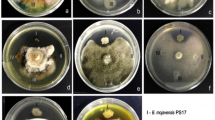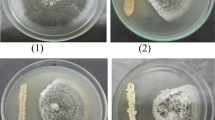Abstract
Four defective (AFM−) mutants of Paenibacillus sp. HKA-15 that no longer produced the peptide antifungal metabolites were developed through ethyl methane sulfonate (EMS) mutagenesis and used for in vivo experimentation. Reduced percentage of seed germination by mutants DM1 and DM2 (22.5% and 25%, respectively) and a high percent of disease incidence (69.3% and 67%, respectively) compared to wild-strain HKA-15 (80% seed germination and 27% disease incidence) indirectly indicated the role of peptide metabolite on disease suppression. Plants treated with AFM− clones showed stunted growth and the presence of pepperlike microsclerotia in the stem tissues. Light and scanning electron microscopic studies clearly showed the effect of peptide antibiosis on hyphal morphology. Exposure to crude extracts of antibiotics produced abnormal contraction of fungal cytoplasm, granulation, and fragmentation of hyphal mycelia and cell lysis. The presence of bacterial cells in the lumen of degrading fungal mycelium suggested a direct involvement of Paenibacillus sp. HKA-15 in the lysis of Rhizoctonia bataticola.



Similar content being viewed by others

Literature Cited
Cook GE, Boosalis MG, Dunkle LD, Wodvony G (1973) Survival of Macrophomina phaseolina in corn and sorghum stalk residue. Plant Dis Rep 57:873–875
Singh RDN, Kaiser SAKM (1995) Evaluation of some systemic and non systemic fungicides against the charcoal rot pathogen Macrophomina phaseolina of maize. J Trop Agric 33:54–58
Mishra RPN, Singh RK, Jaiswal HK, Kumar V, Maurya S (2006) Rhizobium-mediated induction of phenolics and plant growth promotion in rice (Oryza sativa L.). Curr Microbiol 52:383–389
Bevivino A, Sarrocco S, Dalmastri C, Tabacchioni S, Cantale C, Chiarini L (1998) Characterization of free living maize rhizosphere population of Burkholderia cepacia: effect of seed treatment on disease suppression and growth promotion of maize. FEMS Microbiol Ecol 27:225–237
Senthilkumar M (2006) Studies on the biocontrol mechanisms of soybean bacterial endophytes on charcoal rot fungus: Rhizoctonia bataticola. PhD thesis Indian Agricultural Research Institute, India, pp 87–90
Thomashow LS, Weller DM, Bonsall RF, Pierson LS III (1990) Production of the antibiotic phenazine-1-carboxylic acid by fluorescent Pseudomonas species in the rhizosphere of wheat. Appl Environ Microbiol 56:908–912
Arima K, Imanaka H, Kousaka M, Fukuda A, Tamura G (1964) Pyrrolnitrin, a new antibiotic substance produced by Pseudomonas. Agric Biol Chem 28:575–776
Howell CR, Stipanovic RD (1980) Suppression of Pythium ultimum induced damping off of cotton seedlings by Pseudomonas fluorescens and its antibiotic, Pyoluteorin Phytopathol 70:712–715
Shanahan PA, Borro F, O’Gara, Glennon JD (1992) Isolation, trace enrichment and liquid chromatographic analysis of diacetyl phloroglucinol in culture and soil samples using UV and amperometric detection. J Chromatogr 606:171–177
Martin NI, Hu H, Moake MM, Churey JJ, Whittal R, Worobo RW, Vederas JC (2003) Isolation, structural characterization, and properties of mattacin (polymyxin M), a cyclic peptide antibiotic produced by Paenibacillus kobensis M. J Biol Chem 278:13; 124–13,132
Beatty PH, Jensen SE (2002) Paenibacillus polymyxa produced fusaricidin-type antifungal antibiotics active against Leptosphaeria maculans, the causative agents of blackleg disease of canola. Can J Microbiol 48:159–169
Kajimura Y, Sugiyama M, Kaneda M (1995) Bacilopeptins, new cyclic lipopeptide antibiotics from Bacillus subtilis FR-2. J Antibiot 48:1095–1103
Selim S, Negrel J, Govaerts C, Gianinazzi S, van Tuinen D (2005) Isolation and partial characterization of antagonistic peptides produced by Paenibacillus sp. strain B2 isolated from the sorghum mycorrhizosphere. Appl Environ Microbiol 71:6501–6507
Bechinger B (1997) Structure and functions of channel-forming peptides: magainins, cecropins, mellitin and alamethicin. J Membrane Biol 156:197–211
Laemmli LK (1970) Cleavage of structural proteins during the assembly of head of bacteriophage T4. Nature 227:680
Vincent JM (1970) A manual for the practical study of the root nodule bacteria. Blackwell Scientific, Oxford, pp 1–13
Lee WH, Kobayashi DY (1989) Isolation and identification of antifungal Pseudomonas sp. from sugarbeet roots and its antibiotic products. Korean J Plant Pathol 4:264
Gupta CP, Dupey RC, Kang SC, Maheshwari DK (2001) Antibiosis-mediated necrotrophic effect of Pseudomonas GRC2 against two fungal plant pathogens. Curr Sci 81:91–94
Shweta B, Shivani B, Dubey RC, Maheshwari DK (2003) Antagonistic effect of fluorescent pseudomonads against Macrophomina phaseolina that cause charcoal rot of ground nut. Ind J Exp Biol 41:1442–1446
Acknowledgments
The authors are grateful to the Director of NRC for soybean Indore, India for providing soybean seeds. The first author thanks the Indian Council of Agricultural Research (ICAR), India for a PhD fellowship.
Author information
Authors and Affiliations
Corresponding author
Rights and permissions
About this article
Cite this article
Senthilkumar, M., Govindasamy, V. & Annapurna, K. Role of Antibiosis in Suppression of Charcoal Rot Disease by Soybean Endophyte Paenibacillus sp. HKA-15. Curr Microbiol 55, 25–29 (2007). https://doi.org/10.1007/s00284-006-0500-0
Received:
Accepted:
Published:
Issue Date:
DOI: https://doi.org/10.1007/s00284-006-0500-0



